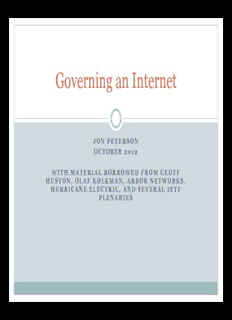Table Of ContentGoverning an Internet
JON PETERSON
OCTOBER 2012
WITH MATERIAL BORROWED FROM GEOFF
HUSTON, OLAF KOLKMAN, ARBOR NETWORKS,
HURRICANE ELECTRIC, AND SEVERAL IETF
PLENARIES
What is the Internet?
This is a deceptively tricky question
A series of tubes?
Don’t laugh at Ted Stevens
A collection of routers?
The smarts to move things between tubes
An agreement of companies?
Interconnection, peering, compensation
A stack of protocols?
The Internet Protocol (IP), among many others?
A definition, for today
The Internet is
An overlay over a diverse set of physical networks, with the
property that:
any computer with an Internet Protocol address can send
arbitrary information to any other computer with an Internet
Protocol address
IP is the glue that binds physical networks to
applications
The “waist of the hourglass”
Many different physical networks run below it
Many different applications run above it
So who controls IP?
IP invented by Vint Cerf and Bob Kahn
Specified in a document series called the Requests for Comment (RFCs):
IPv4 circa 1981 [RFC791]
Most Internet protocols are specified in RFCs
Email, the web, Voice over IP, TCP, BGP, DNS, TLS, you name it
Today, the Internet Engineering Task Force publishes standard RFCs
The standards of the Internet
The IETF has change control over IP as a specification
IP addresses originally handled by Jon Postel (1943-1998)
Along with domain names, when they came around
Eventually, this job had to migrate to a team
The first “Internet Architect” was Dave Clark
Eventually, his position was fielded out to an appointed group called the
Internet Architecture Board
IPv4, IPv6 and the Internet
You’ve probably heard that the IPv4 space is depleted
The IETF developed a protocol called IPv6 with more address space
However, IPv6 has not yet become mainstream
The Internet’s stakeholders invested tremendously in IPv6
Lack of adoption is a constant challenge and puzzle
The IAB is responsible for the administration of protocol
parameter values managed by IANA
IANA formed to carry on the work of Jon Postel (1943-1998)
Maintains records for the root of the DNS, autonomous system
numbers, IP address allocation, and various related fields
So who can make IPv6 happen, then?
Who to Blame?
IANA
Internet Assigned Numbers Authority
IAB
Internet Architecture Board
ICANN
Internet Corporation for Assigned
Names and Numbers
Regional Internet
Registries (RIRs)
ARIN, RIPE, AFRINIC, APNIC,
LACNIC
Pretty much everyone
In the beginning…
IPv4 came out in the early 1980s
The young Internet lived in a world of mainframes
Many user terminals leashed to one central machine on the Internet
Personal microcomputers in the first generation, few modems even
Internet backbone ran only to advanced research facilities
Only researchers really cared about Internet resources
IPv4 uses 32-bit addresses: e.g., 134.10.2.45
Surely 4.2B addresses are enough!
"I think there is a world market for maybe five
computers." – surely apocryphal remark attributed to
Thomas Watson, chairman of IBM
Address Blocks and Classes
Originally, IPv4 allocated carelessly (see [RFC943])
Class A (/8)
16,777,216 IPv4 Addresses
Stanford: 36.0.0.0/8 (Student body: 6000U/8000G)
1/256th of the entire IP addressing space!
Famously, 1st IETF Chair Mike Corrigan had his own (21.0.0.0/8)
Class B (/16)
65,536 IPv4 Addresses
Reed College: 134.10.0.0/16 (for ~1200 students)
Stanford had one of these too (128.12.0.0/16)
Class C (/24)
256 IPv4 Addresses
Class D and E never saw much use (multicast)
Simplified routing: easy to aggregate prefixes
Presented at
the IETF in
1990
We’ve known IPv4
depletion was coming
for a long time
These notes predict
Class B depletion
“Imminent death of the
net predicted,” but
didn’t happen quite as
people thought then
Growing Importance of the Internet
By the early 1990s, the Internet had grown up
Jon Postel simply could not scale anymore, IANA became a discrete
entity
From this point forward, only multi-stakeholder address
assignments were feasible
InterNIC, RIPE NCC and APNIC all founded around 1992
ICANN created in 1998 as a successor to InterNIC
ARIN formed in 1997 to administer IP addresses
Takes large blocks from IANA to distribute in North America and the
Caribbean
Jon Postel originally on the board
Originally covered Latin America and Africa as well
Eventually split off into LACNIC and AfriNIC
People started to care who owned which addresses
Ultimately, the root of may security questions
Description:OCTOBER 2012. WITH MATERIAL surely apocryphal remark attributed to. Thomas . default-free zone of prefix routing NATs optimize for client-server connections Nortel sold 666,624 IPv4 addresses to Microsoft for. $7.5M in

